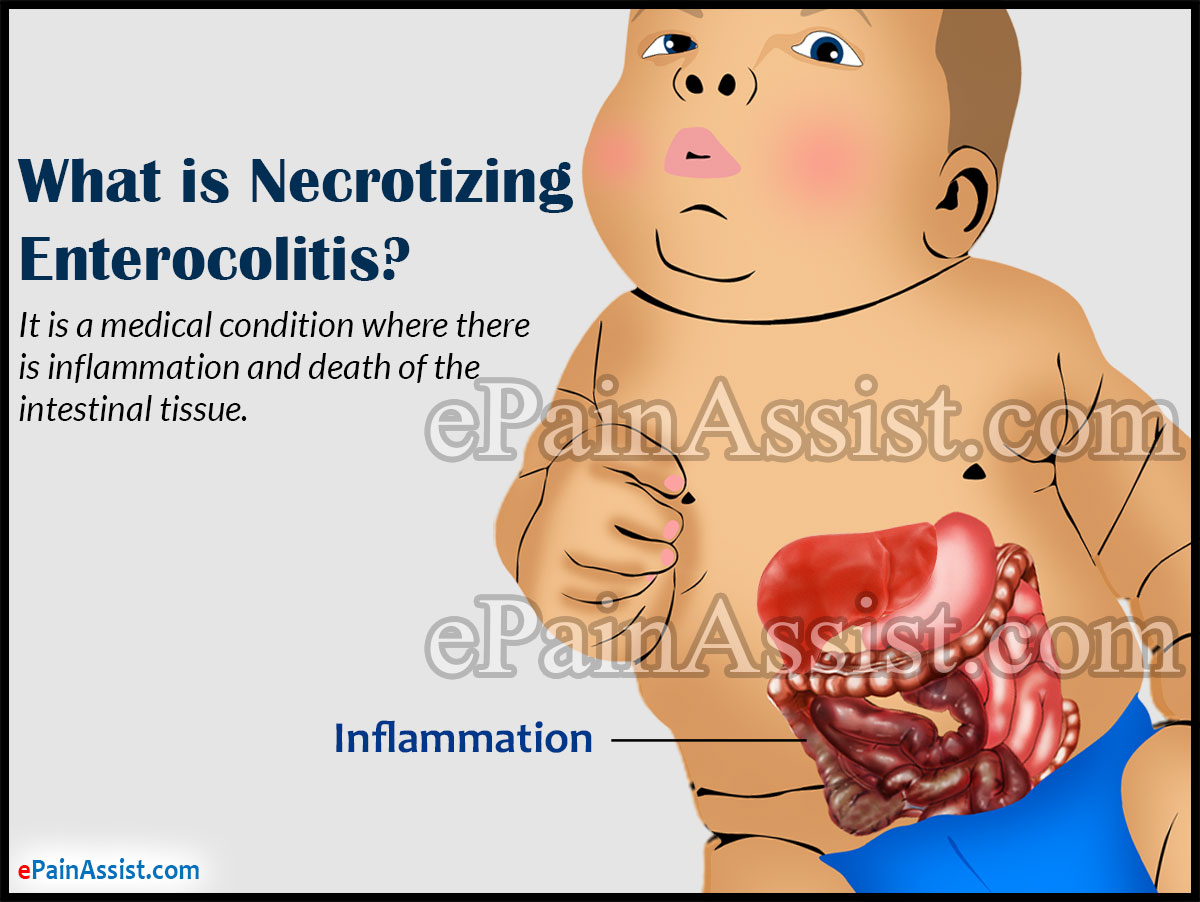What is Necrotizing Enterocolitis?
Necrotizing enterocolitis (NEC) is a medical condition where there is inflammation and death of the intestinal tissue. Only the lining of the intestine can be affected or the complete intestinal thickness can be involved. In severe cases of Necrotizing enterocolitis, there may be perforation of the intestine where a hole will form in the intestinal wall due to which the bacteria present in the intestine leaks into the abdomen resulting in fatal widespread infection. Necrotizing enterocolitis is commonly seen in premature babies.

There are many newborn babies who go on to live normal and healthy lives after they grow up. But there are some children who continue to have persistent problems with growth, development and digestion. Necrotizing enterocolitis often develops within the first 2 weeks after the baby is born; however, it can also occur in the period of 3 months after the baby’s birth.
Necrotizing enterocolitis or NEC, if left untreated, can prove to be a life threatening condition.
Causes of Necrotizing Enterocolitis & Prevention
- The exact cause of necrotizing enterocolitis is not clear.
- It is thought that if the baby’s digestive and immune systems do not develop in the right manner, then Necrotizing enterocolitis can occur.
- If the baby is born prematurely.
- If there were problems during pregnancy or delivery, especially insufficient oxygen during delivery. Then it can cause Necrotizing enterocolitis.
- It is also thought that formula fed babies are more prone to developing necrotizing enterocolitis than breastfed babies.
- Infants who are at the risk of developing Necrotizing enterocolitis are recommended to take probiotics. Probiotics are bacteria which help in maintaining the natural balance of the intestinal microflora.
Signs & Symptoms of Necrotizing Enterocolitis
Symptoms of Necrotizing Enterocolitis depend on the severity of the condition and include:
- The baby will have a tender, swollen, shiny or red belly.
- There can be constipation also.
- Patient suffering from necrotizing enterocolitis can pass dark colored, black, or bloody stools.
- Symptoms of fever along with chills can be present in patients suffering from Necrotizing enterocolitis.
- The body temperature can be low or unstable.
- The breathing is very fast.
- Patient has tachycardia or rapid heartbeat.
- Patient does not accept any feeds.
- Vomiting.
- Baby is listless, less active or has less energy.
Investigations to Diagnose Necrotizing Enterocolitis
A thorough physical examination of the baby along with symptoms is carried out. The following investigations are also done:
- X-ray of the baby’s belly.
- Fecal occult blood test is done to check for blood in the baby’s stool.
- Tests are done to look for bacteria in the blood, stool, urine or spinal fluid.
Treatment for Necrotizing Enterocolitis
- Treatment for Necrotizing Enterocolitis depends on the severity of the condition, the age of the baby and the general health of the baby.
- Necrotizing enterocolitis treatment can last for a week to 10 days.
- The baby will be admitted to the hospital’s neonatal intensive care unit (NICU).
- The baby suffering from Necrotizing enterocolitis is fed intravenously. All oral feedings are stopped.
- Antibiotics are given to fight with the infection associated with Necrotizing enterocolitis.
- A tube is inserted through the nose to the stomach which removes excess fluids and gas present in the intestine.
- Surgery for Necrotizing enterocolitis is done in severe cases where the baby is not getting better or if perforation develops in the intestine.
- Around 1 out of 4 babies having necrotizing enterocolitis need surgery.
- Surgery for Necrotizing Enterocolitis is done in two parts with these two procedures being weeks or months apart.
- The first surgery for Necrotizing enterocolitis involves removing the damaged/dead parts of the intestine and creating an ileostomy or a colostomy. This is done so that the intestine can rest and heal.
- In ostomy, the stool exits the body via an opening in the belly and gets collected in a bag.
- The second surgical treatment for Necrotizing enterocolitis is done to close the ostomy site and allow the stool to pass normally through the body again.
- After the treatment for Necrotizing enterocolitis is complete, the baby will be discharged if he/she is accepting feeds and not losing weight.
- The nurse from the hospital will instruct you on how to feed and care for the baby at home.
- Parents of the baby tend to feel overwhelmed regarding the baby’s health. It is advised to consult with a counselor or a social worker regarding your feelings and to relieve stress.
-
MedlinePlus – Necrotizing Enterocolitis: MedlinePlus provides comprehensive information about necrotizing enterocolitis, including its causes, symptoms, diagnosis, and treatment. https://medlineplus.gov/ency/article/001148.htm
-
Stanford Children’s Health – Necrotizing Enterocolitis: Stanford Children’s Health offers information on necrotizing enterocolitis, covering its causes, symptoms, diagnosis, and treatment options. https://www.stanfordchildrens.org/en/topic/default?id=necrotizing-enterocolitis-90-P01805
-
Children’s Hospital of Philadelphia – Necrotizing Enterocolitis: CHOP offers detailed information on NEC, its risk factors, symptoms, diagnosis, and management, including medical and surgical treatments. https://www.chop.edu/conditions-diseases/necrotizing-enterocolitis
